A Comprehensive Guide to Sautéed Sea Scallops
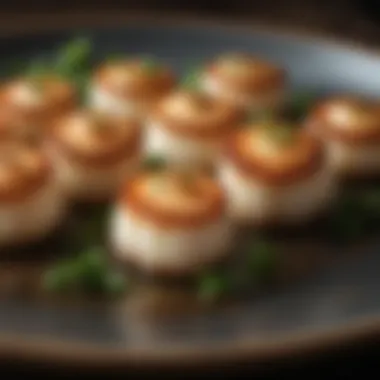
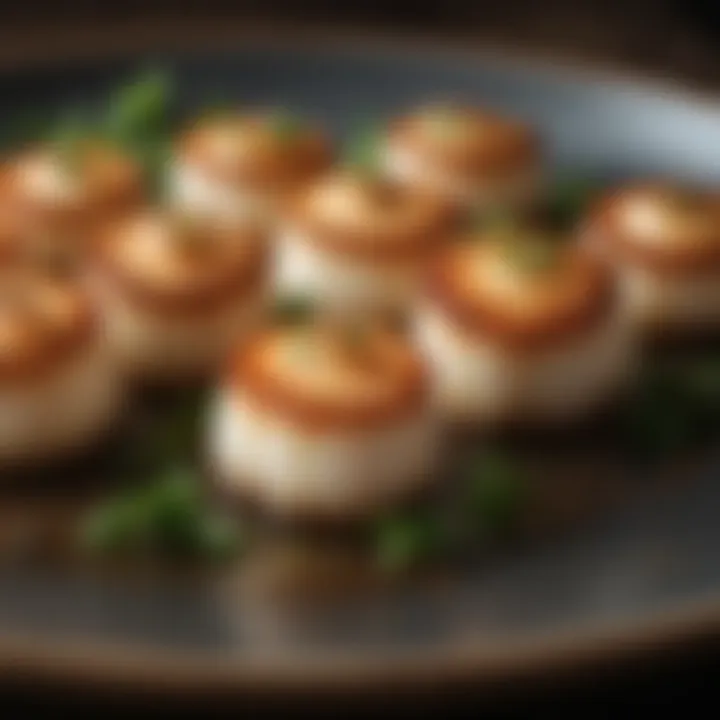
Intro
Sea scallops are a delightful seafood choice celebrated for their tender texture and rich flavor. This culinary gem is often prepared through sautéing, which highlights their natural sweetness. In this comprehensive guide, we will delve into various aspects of sautéed sea scallops, from optimal sourcing practices to cooking techniques, while also touching on the nutritional advantages they offer. Moreover, we will examine the importance of sustainability in scallop harvesting, ensuring a mindful approach to seafood consumption.
Our goal is to provide readers with a thorough understanding of preparing and enjoying sautéed sea scallops, perfect for enthusiasts seeking to refine their culinary skills.
Wellness
Nutrition and Diet
Sautéed sea scallops are not just a treat for the taste buds; they also pack a notable nutritional punch. High in protein and low in calories, they are an excellent choice for those seeking to maintain a healthy diet. A single serving of sea scallops typically contains around 20 grams of protein while offering essential vitamins such as B12 and minerals such as selenium. These nutrients support various bodily functions and enhance overall health. Incorporating scallops into your meals can be a smart decision for those focusing on nutrition without sacrificing taste.
Physical Health
The health benefits of including sautéed sea scallops in your diet extend to physical health. Their high protein content supports muscle repair and growth, making them ideal for active individuals. Furthermore, the omega-3 fatty acids present in scallops contribute to heart health by reducing inflammation and lowering blood pressure. Aiming for a balanced plate that features sautéed sea scallops can be a step toward better physical well-being.
Mental Health
While enjoying exquisite meals can elevate one’s mood, the nutritional simplicity of sea scallops may also have a positive impact on mental health. Consuming nutrient-dense seafood can contribute to brain health, potentially lowering the risk of cognitive decline. Simple yet elegant, meals centered around sautéed sea scallops beckon not just satisfaction but comfort, which can soothe the mind and promote a sense of contentment.
"Eating high-quality seafood like scallops can enhance both physical and mental wellness, supporting a holistic approach to health."
Tools for Living Better
Health Tips
To incorporate sautéed sea scallops effectively into your diet, consider these health tips:
- Choose fresh scallops: Opt for scallops that appear moist and translucent, with a distinct briny scent, indicating freshness.
- Sauté with healthy fats: Use heart-healthy options like olive oil or avocado oil while preparing scallops to maximize flavor and health benefits.
- Pair wisely: Complement scallops with nutrient-rich vegetables to create a balanced meal.
Quick Recipes
Here are two simple recipes to get you started:
- Lemon Garlic Scallops
- Scallops with Asparagus
- Ingredients: Fresh sea scallops, minced garlic, lemon zest, olive oil, salt, and pepper.
- Instructions: Sauté garlic in olive oil, add scallops, season, and cook until golden, then finish with lemon zest.
- Ingredients: Fresh sea scallops, asparagus, butter, garlic, and lemon juice.
- Instructions: Sauté asparagus in butter, add scallops and garlic, cook quickly, and drizzle with lemon juice.
These recipes highlight the versatility of scallops and can easily be adapted to suit various tastes.
Understanding Sea Scallops
Understanding sea scallops is crucial to truly appreciating their culinary potential and nutritional value. This section illuminates various facets of sea scallops, showcasing their biological characteristics and different types. By gaining insight into these elements, the reader can better comprehend the advantages of incorporating sea scallops into their diet and culinary repertoire.
Biology and Habitat
Sea scallops, scientifically termed Placopecten magellanicus, are bivalve mollusks found primarily in the North Atlantic Ocean. They thrive in sandy or muddy seabeds, often at depths ranging from 10 to 200 meters. They have a unique physiology that enables them to swim by rapidly expelling water through their shells. This characteristic is essential for evading predators. Their habitat is not only integral to their survival but also influences their taste and texture, which are key qualities for culinary use.
Types of Sea Scallops
Different types of sea scallops offer a variety of flavors and textures, making them suitable for diverse culinary applications. The two main types discussed here are Atlantic scallops and Pacific scallops. Each type possesses distinct characteristics that influence their popularity in cooking.
Atlantic Scallops
Atlantic scallops are perhaps the most well-known type. They are characterized by a slightly sweet flavor and a firm texture. This makes them an ideal choice for sautéing. The sustainability of Atlantic scallops is also noteworthy; they are often harvested using methods that minimize environmental impact. This added benefit aligns with increasing consumer demand for responsible seafood choices. Their sweetness is enhanced when simply seasoned and sautéed, making them a common feature on restaurant menus.
Another unique feature is their relatively large size, which allows for a pleasing presentation in dishes. However, they can be prone to overcooking if not monitored closely during preparation, resulting in a rubbery texture.
Pacific Scallops
Pacific scallops differ significantly from their Atlantic counterparts. They possess a more delicate, buttery flavor profile. This distinct taste makes them a preferred option for certain gourmet dishes. Pacific scallops are generally smaller than Atlantic scallops, which can impact cooking times. The size difference also requires slightly more attention when searing them, to avoid overcooking.
While Pacific scallops can be found on many menus, their availability may be less consistent than that of Atlantic scallops, depending on seasonal factors. Additionally, the harvesting methods for Pacific scallops may not always align with the best sustainability practices, which is an important consideration for environmentally conscious consumers.
Nutritional Profile
The nutritional profile of sea scallops is a crucial aspect of understanding their value as a seafood choice. This profile highlights their health benefits and informs culinary decisions. Knowing what makes sea scallops nutritionally appealing helps readers appreciate their role in a balanced diet while enjoying their delightful flavor.
Health Benefits of Sea Scallops
High Protein Content
High protein content is one of the most significant attributes of sea scallops. A serving of scallops typically contains around 20 grams of protein per 3-ounce portion. This makes them an excellent source of lean protein for those looking to maintain muscle mass or increase satiety in meals. Moreover, protein is essential for numerous bodily functions, including tissue repair and immune response. Thus, incorporating sea scallops into the diet can be advantageous for both health and culinary satisfaction. However, it's essential to consider individual dietary needs. Some may require higher protein intake, while others may not.
Rich in Omega-3 Fatty Acids
Sea scallops are also rich in omega-3 fatty acids, which are known for their anti-inflammatory properties and cardiovascular benefits. These healthy fats play a vital role in brain health and help reduce the risk of chronic diseases. Incorporating omega-3 fatty acids through sea scallops is a flavorful choice that can enhance meals. Yet, it is important to ensure that the scallops are sourced sustainably. Overfishing has created concerns around seafood availability, and supporting responsible practices contributes to long-term benefits for both health and the environment.

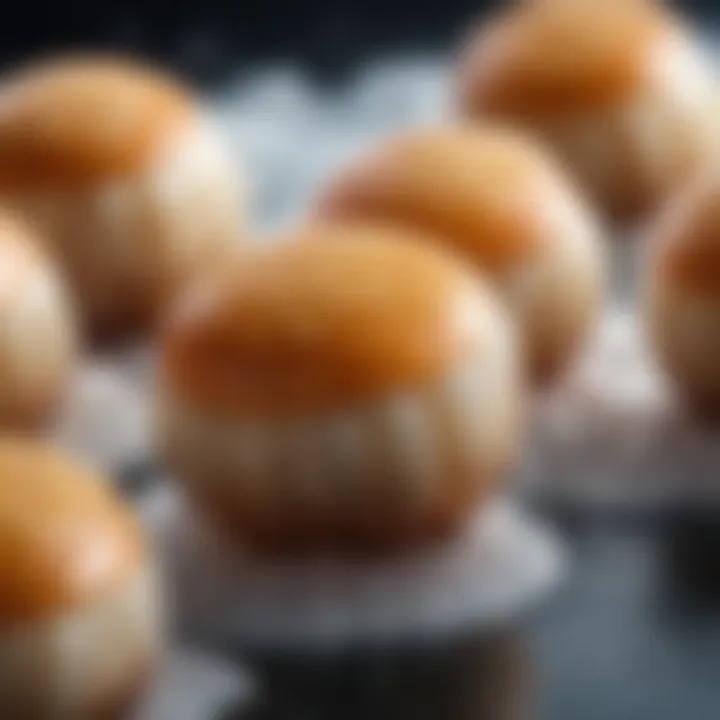
Low in Calories
Low calorie count is another appealing feature of sea scallops. With approximately 90 calories per 3-ounce serving, they present a nutritious option for those who seek to manage their weight without sacrificing flavor. The low-calorie aspect makes them suitable for a variety of diets, including low-carb or calorie-restricted plans. Scallops can be a great way to enjoy a satisfying meal while adhering to dietary goals. However, pairing them with high-calorie sauces or sides may offset their inherent low-calorie advantage, which requires careful meal planning.
Potential Allergens and Considerations
Although many people enjoy sea scallops, potential allergens should be noted. Shellfish is one of the most common food allergens and can cause reactions in sensitive individuals. Another consideration is the source of the scallops, as those from polluted waters may contain harmful toxins. Therefore, sourcing from reputable suppliers is vital for health safety.
"Being aware of the nutritional aspects and sourcing of scallops can significantly enhance not only your culinary experience but also your health outcomes."
Sourcing Fresh Sea Scallops
Sourcing fresh sea scallops is a pivotal aspect of preparing this exquisite seafood. Quality directly influences the taste and texture of the dish. Sourcing fresh is not only a matter of flavor but also speaks volumes about sustainability and ethics in dining. Consumers today are more aware of the implications of their food choices. Thus, understanding how to select good quality scallops improves the overall culinary experience.
Identifying Quality Scallops
Quality scallops can be identified through several key characteristics. Freshness is paramount. When seeking scallops, look for a firm, plump texture. They should have a moist surface rather than being dry. A glossy appearance often indicates freshness. The smell is another crucial factor; they should smell like the sea—not overly fishy. If they are still in their shells, the shells should be tightly closed or close when touched. Open shells may signify that they are not fresh. It’s also advisable to buy scallops from reputable seafood markets or suppliers who can vouch for the sustainability of their products.
Quality also relates to the size of the scallops. Larger varieties, such as the Atlantic scallops, are often more preferable for sautéing. They hold up well during cooking. However, smaller scallops can be used effectively in pasta or soups where a subtler texture is desired.
Sustainable Seafood Practices
Sustainability in seafood sourcing involves ensuring that marine life is harvested in a way that maintains the balance of marine ecosystems. As more consumers gravitate towards environmentally conscious choices, understanding certifications and supporting local fishermen is essential.
Understanding Certifications
Understanding certifications is integral to responsibly sourcing sea scallops. Organizations like the Marine Stewardship Council (MSC) offer certification programs that indicate sustainable fishing practices. Recognized certifications are markers of responsible harvesting techniques. They help consumers choose products that do not contribute to overfishing or habitat destruction. Such certifications ensure that the fishery operates under rules that protect the marine environment and its biodiversity.
The key characteristic of these certifications is the traceability they provide. Seafood products that carry such labels typically allow tracking back to their origin. This is not only beneficial for buyers wanting quality seafood but also promotes transparency in the supply chain. The unique feature of certified scallops is the assurance of sustainability, giving consumers peace of mind knowing their choices contribute positively to marine ecosystems.
However, it is essential to be discerning, as not all certifications are equal. Some could be less stringent than others, leading to confusion about their actual sustainability. Thus, research is needed to understand what these certifications entail fully.
Supporting Local Fishermen
Supporting local fishermen plays a vital role in sustainable seafood practices. When consumers choose to buy from local sources, they often contribute to the local economy and partake in more responsible fishing practices. Local fisheries tend to have better control over their harvesting methods and can provide fresher products. This is especially true in coastal communities where seafood is a primary source of livelihood.
The key characteristic of supporting local fishermen is the relationship between consumers and fishers. This local connection fosters transparency about fishing practices. With fewer intermediaries, it is easier to trace the scallops back to their source. This support is beneficial for the community and encourages environmentally friendly practices that help preserve local fish populations.
A unique feature of this support is its impact on food systems. Choosing local seafood over mass-produced items reduces the carbon footprint associated with transportation. However, it is essential to evaluate local fishing practices to ensure they are genuinely sustainable. Always ask local fishers about their methods and certifications to ensure that your choices align with your values.
Preparing Sea Scallops
Preparation is a vital stage when it comes to cooking sea scallops. It sets the groundwork for achieving that perfect texture and flavor that defines an exceptional dish. Proper preparation can enhance not only the taste but also the presentation of the scallops. This section will cover two primary aspects: defrosting techniques and the cleaning and drying processes. These procedures will ensure the scallops are in optimal condition before they meet the heat.
Defrosting Techniques
When working with frozen sea scallops, proper defrosting is crucial. Scallops can easily become rubbery if defrosted improperly. The most recommended method is to thaw them slowly and gently in the refrigerator. This takes several hours but is generally the safest approach. Here’s how to do it:
- Place the scallops in a container: Use a dish or bowl to contain any moisture that might escape.
- Refrigerate overnight: Let the container sit in the refrigerator for about 8 to 12 hours.
For those in a hurry, a quicker method involves submersion in cold water:
- Use a sealed bag: Ensure the scallops are in a leak-proof bag, submerging it in a bowl of cold water.
- Change water every 30 minutes: It can take anywhere from 1 to 2 hours.
Avoid defrosting in warm or hot water, as this will cook the outside and leave the inside cold, affecting texture and taste. Also, never leave them out on the counter to thaw since this can promote bacterial growth.
Cleaning and Drying
Once thawed, cleaning is essential for removing any sand or grit. First, rinse the scallops under cold water for a few seconds. Pay attention to the outer edge where shell bits might cling. After rinsing, it’s important to dry them thoroughly.
- Use a paper towel: Gently pat each scallop dry. Removing excess moisture is critical for achieving that golden-brown sear during cooking.
- Inspect for muscle or roe: If there is a small, tough muscle on the side, this should be removed. Also, roe should be discarded if you prefer a lighter flavor in your dish.
Drying scallops can be enhanced by leaving them in the refrigerator for about 30 minutes after patting. This will help to form a nice crust when they are sautéed. The combination of proper defrosting and careful cleaning prepares the scallops perfectly for cooking, allowing their natural flavors to shine through.
Sauteing Techniques
Sauteing is a crucial technique in the culinary arts, especially when it comes to cooking sea scallops. This method allows for quick cooking at high temperatures, ensuring that its delicate texture remains intact while achieving a beautiful golden crust. Mastering the art of sauteing involves understanding the different aspects such as pan selection, ingredient choices, and the control of cooking time and heat. Each element contributes significantly to the final outcome, enhancing the flavors and appearance of the dish.
Choosing the Right Pan
The choice of pan can greatly influence the cooking process and the outcome. A heavy-bottomed skillet or a non-stick frying pan is ideal for sauteing sea scallops. These types of cookware provide even heat distribution, which is essential for avoiding hotspots that can cause uneven cooking.
A well-seasoned cast iron skillet is also popular among chefs, as it retains heat effectively, contributing to a perfect sear. Be careful when using lighter pans, as they may not sustain the required cooking temperature, resulting in an unfinished product. The right pan ensures the scallops have that desired crispy exterior while remaining tender inside.
Essential Ingredients
Fats and Oils
Fats and oils play a vital role in the sauteing process. They not only help in heat transfer but also enhance the flavor of the scallops. Using oils with high smoke points, like canola or grapeseed oil, is advantageous because it allows you to reach higher temperatures without burning.
Butter is a popular choice for its rich flavor and ability to add richness. However, combining it with oil can prevent it from browning too quickly, allowing the scallops to cook perfectly. This mixture creates a balanced flavor and prevents bitterness that can result from overheating.
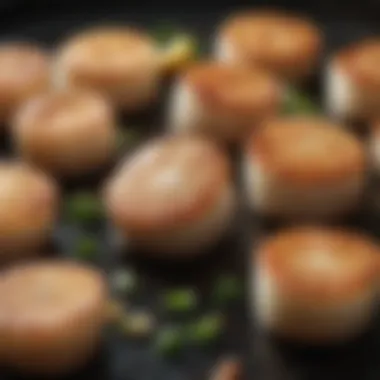
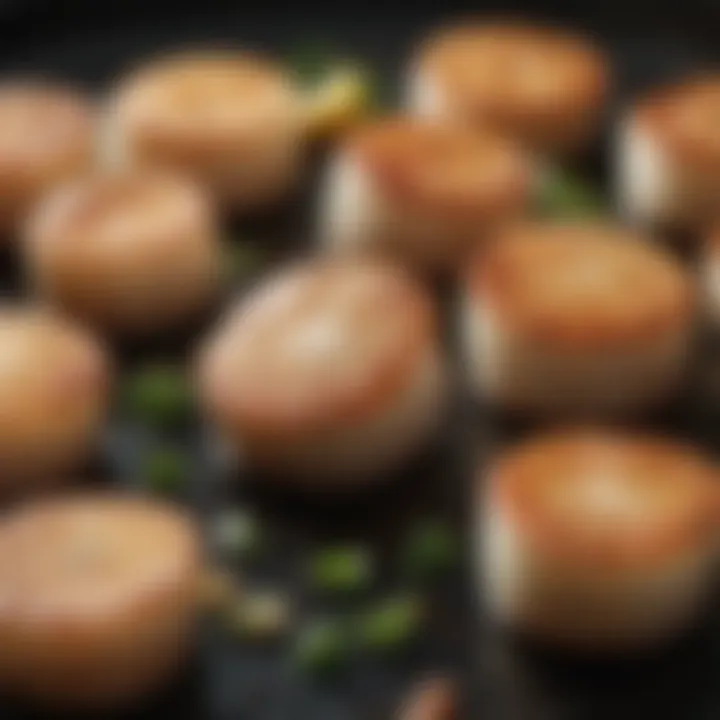
Aromatics
Aromatics are essential in elevating the dish's overall flavor. Onions, garlic, or shallots are common choices that enhance the bouquet and taste. They release their essence quickly during the sauteing process, complementing the natural sweetness of the scallops. One must be cautious not to overcook aromatics, as they can turn bitter and distract from the scallops’ flavor.
When using aromatics, timing is a critical factor. These should be added early in the cooking process, allowing their flavors to meld with the fats and oils before introducing the scallops.
Seasonings
Seasonings are the final touch that can make or break your sauteed scallops. Salt and pepper are traditional yet powerful. They not only highlight the fresh flavors of the scallops but also enhance the overall cooking experience.
Fresh herbs like parsley or thyme can also be incorporated for added depth, providing a burst of freshness. Using lemon zest or juice gives a pleasant acidity that cuts through the richness of the butter and oils, balancing the dish gracefully. However, it's important to avoid overseasoning, as this can mask the delicate taste of the seafood.
Cooking Times and Temperature Control
Cooking times and temperature control are vital to achieving perfect sauteed sea scallops. Ideally, they should be cooked for about two to three minutes on each side. Scallops are highly sensitive to overcooking, leading to a rubbery texture. High heat is necessary to create that desirable caramelization while ensuring the insides remain moist.
Using a thermometer can be helpful to ensure they reach an internal temperature of about 125°F (52°C). Keep an eye on the scallops; they should turn opaque and retain a slight translucence in the center when done. Monitoring both time and temperature closely will deliver the best results, enhancing both the flavor and texture of this culinary delight.
Flavor Pairings
Flavor pairings are essential in enhancing the overall dining experience with sauteed sea scallops. When prepared well, sea scallops possess a subtle sweetness and tender texture that can be elevated with the right accompanying ingredients. Pairing scallops with complementary flavors can transform a simple dish into a sophisticated culinary experience. To achieve this, it is important to consider the balance of flavors, textures, and aromas in your meal.
Complementary Vegetables
Selecting the right vegetables to accompany sea scallops can greatly influence the dish's final flavor profile. Vegetables like asparagus, zucchini, and bell peppers not only add colour but also provide a contrast in texture. For instance, asparagus has a slight crunch, which pairs well with the softness of the scallops. Additionally, vegetables can contribute essential nutrients, enhancing the dish's health benefits. It is advisable to steam or sauté these vegetables lightly to retain their freshness while achieving a harmonious mix of flavors.
Accompaniments and Sauces
Accompaniments and sauces play a significant role in enriching the flavor of sauteed sea scallops. Here are two notable options:
Herb-infused Oils
Herb-infused oils are a popular choice for dressing scallops, providing a rich layer of flavor. These oils can be made with various herbs, such as basil or thyme, which impart their essence into the oil, creating a fragrant enhancement to the dish. One key characteristic of herb-infused oils is their versatility, as they can be used not only on scallops but also on other seafood or grilled meats. The unique feature of these oils is their ability to absorb the flavors of the herbs, offering a pleasant aroma that complements the sweetness of the scallops. However, it is essential to use high-quality oils to ensure that the flavor is well-balanced and does not overpower the dish.
Citrus-based Reduction
Citrus-based reductions offer a bright, zesty contrast to the rich flavor of scallops. This sauce is made by simmering citrus juices, like lemon or orange, until they reduce and intensify in flavor. The key characteristic of a citrus-based reduction is its acidity, which can complement the natural sweetness of scallops. This sauce not only adds brightness but also enhances the seafood’s natural flavours. The unique advantage of using citrus-based reductions is their ability to clean the palate, making each bite refreshing. Nevertheless, it is important to balance the acidity with other flavors to avoid overwhelming the dish.
When choosing complementary elements for scallops, always aim for a balance between rich and fresh flavors. This will create a well-rounded dish that is truly enjoyable.
Presenting and Serving
The experience of enjoying sautéed sea scallops extends beyond mere taste; it encompasses presentation and serving techniques that elevate the dining experience. Proper plating is not just an aesthetic choice, but a way to highlight the delicate nature and rich flavors of scallops. This attention to detail not only enhances visual appeal but also contributes to the overall enjoyment of the dish.
Plating Techniques
When plating sautéed sea scallops, consider using a warm plate to maintain the temperature of the dish. Start by laying a base with complementary ingredients. This could be a puree or a vegetable mash that provides a contrasting color. Arrange the scallops in a pattern—often a circular or cascading arrangement works best.
Garnishing adds a finishing touch; fresh herbs, microgreens, or a drizzle of herb-infused oil can provide not only color but also enhance the flavors. Keeping the presentation clean and uncluttered is key. Avoid crowding the plate and allow your scallops to take center stage, enhancing their appeal.
Wine Pairings
White Wines
White wines are typically recommended for pairing with seafood due to their acidity and crispness, which complement the sweetness of scallops. Varieties like Sauvignon Blanc and Chardonnay are popular choices. Sauvignon Blanc's zesty citrus notes highlight the natural flavors of the scallops, making it a refreshing option for those who appreciate a punch in their wine.
Chardonnay, particularly un-oaked versions, offers a balanced choice with its notes of apple and pear. These characteristics can accentuate the depth of the scallops while keeping the palate clean.
However, it is important to consider sweetness levels in your choices when picking a white wine to accompany your dish. Too sweet a wine can overwhelm the dish, while a perfectly balanced one enhances the flavors.
Sparkling Options
Sparkling wines can also be an excellent companion to sautéed sea scallops. The effervescence of options like Champagne or Prosecco cuts through rich flavors, offering a refreshing contrast. The high acidity and bubbles propel the dish’s freshness.
Champagne, with its complexity and depth, adds a luxury element when served alongside scallops. Its mineral quality can further enhance the umami nature of seafood, which many find appealing. On the other hand, Prosecco has a lighter, fruitier profile that appeals to those seeking something less intense. While the unique features of Prosecco may cater to casual dining, it might lack the depth that some diners prefer in more formal settings.
"The beauty of a dish is part of the experience; when flavors are combined with visual appeal, it creates a memorable dining occasion."
Culinary Variations of Sauteed Sea Scallops
Culinary variations of sauteed sea scallops provide a rich opportunity to explore diverse flavors and techniques. These variations are important because they allow the cook to experiment with different culinary traditions, enriching their palate and expanding their cooking repertoire. Each regional style brings its own unique elements, drawing from local ingredients and cooking methods. Understanding these variations aids not only in enhancing flavor profiles but also in making informed choices for health and sustainability.
Different cultures have adapted the cooking of scallops in ways that highlight their natural sweetness and delicate texture. Through exploration of Mediterranean and Asian-inspired recipes, cooks can balance flavors and create dishes that are both sophisticated and comforting. Using a variety of ingredients introduces new layer of taste and appeal, which elevate the dish beyond a simple preparation.
Mediterranean Style
Mediterranean cuisine emphasizes fresh, vibrant ingredients paired with healthy fats and herbs. When preparing sauteed sea scallops in a Mediterranean style, cooks often incorporate olive oil, garlic, and a mix of fresh herbs such as parsley and basil.
Key Elements:
- Use high-quality extra virgin olive oil as it adds depth of flavor.
- Incorporate seasonal vegetables such as zucchini or bell peppers, seared alongside the scallops.
- Finish the dish with a splash of lemon juice for brightness.
- Consider adding a pinch of red pepper flakes for heat.


Benefits:
Using Mediterranean ingredients adds not only flavor but also nutritional benefits. For instance, the addition of olive oil provides heart-healthy fats. Moreover, herbs contribute antioxidants. The resulting dish is not only tasty but also appealing for health-conscious diners.
Asian-inspired Recipes
Asian culinary traditions offer diverse ways to prepare sauteed sea scallops, often using bold flavors and aromatic spices.
Common Ingredients:
- Soy sauce or tamari as a base for a savory umami flavor.
- Fresh ginger and garlic for aromatic impact.
- A touch of sesame oil or chili oil to enhance richness and spice.
- Vegetables like bok choy or snap peas to add crunch and color.
Considerations:
Asian-style recipes often highlight stir-frying techniques, which can result in a higher heat, quick-cooking method, preserving the scallops' tender texture. When adapting Asian-inspired variations, focus on balancing flavors between sweet, salty, and sour. This interplay creates complex layers that elevate the dish.
Celestial flavors often elevate simple ingredients into a multifaceted dish.
By embracing culinary variations, readers can cultivate a deeper appreciation for the ocean's bounty, learning to prepare this seafood delicacy in exciting and innovative ways while enjoying its health benefits.
Common Mistakes to Avoid
When it comes to cooking sautéed sea scallops, understanding common mistakes can make a significant difference in the final dish. Recognizing and sidestepping these errors not only enhances the taste but also preserves the delicate texture of scallops. Learning about these pitfalls can lead to a more satisfying dining experience. This section outlines two key errors that often hinder home cooks from achieving the desired results: overcooking and improper seasoning.
Overcooking
Overcooking is perhaps the most frequent mistake made by those who sauté sea scallops. Scallops are delicate and require careful attention. When cooked too long, they can become rubbery and lose their natural sweetness. The ideal sautéed scallop has a golden-brown crust while remaining tender and juicy inside.
To avoid overcooking, consider the following tips:
- Monitor Cooking Time: Generally, scallops require only 2-3 minutes per side, depending on their size. Keep a close eye during cooking to prevent them from becoming tough.
- High Heat Cooking: Use a preheated pan with high heat. This allows for a quick sear while insuring the interior retains moisture.
- Resting Time: After removing the scallops from the pan, let them rest for a minute. This can enhance the overall texture and flavor, making them more enjoyable.
"Cooking is all about timing, especially for delicate seafood like scallops."
By focusing on these aspects, you can ensure your scallops maintain their buttery texture and rich taste.
Improper Seasoning
Another common mistake is improper seasoning. The way you conduct seasoning can largely affect the flavor of the finished dish. A lack of seasoning might lead to bland scallops, while over-seasoning can overpower their subtle taste.
To achieve the right balance:
- Celtic Salt and Pepper: Start with basic seasoning—salt and pepper. They emphasize the natural flavors of the scallops without overwhelming them.
- Incorporate Fresh Herbs: Fresh herbs such as parsley or chives may be used sparingly. They add depth without masking the natural sweetness of scallops.
- Taste as You Go: Always taste a small piece before serving. This practice helps ensure the seasoning is on point.
Avoiding these common mistakes will help elevate your scallop dish and allow you to enjoy all the wonderful flavors they offer.
Exploring Culinary Traditions
Exploring culinary traditions surrounding sea scallops offers valuable insights that enhance the understanding of this exquisite seafood. Culinary traditions are not merely about recipes; they encompass cultural practices, historical contexts, and community connections. In the case of scallops, the ways they are prepared and enjoyed can reflect the heritage of coastal communities. Knowledge of these traditions deepens one's appreciation for the dish as it connects the table to centuries of tradition.
Moreover, recognizing the cultural significance of sea scallops emphasizes their role in various cuisines. As you learn how different societies use scallops, you might find innovative cooking methods, unique flavor combinations, or specific occasions that celebrate this ingredient. This exploration can inspire home cooks and culinary enthusiasts to expand their culinary repertoire and infuse their dishes with authentic flavor.
Cultural Significance of Scallops
Sea scallops have a rich history in many cultures, often symbolizing abundance and luxury. In regions like New England, scallops are central to festive gatherings and familial celebrations. The way scallops have been integrated into local cuisines illustrates their importance beyond mere consumption.
For instance, in France, scallops are often featured in culinary masterpieces and are a staple in coastal dining establishments. Their preparation often highlights skill and tradition, typically seen in dishes like Coquilles Saint-Jacques, where scallops are often baked in a creamy sauce and served in their shells. This not only showcases the ingredients but also pays homage to the coastal heritage of the French culture.
In Japan, scallops are revered in dishes like nigiri sushi. Their fresh, delicate flavor pairs beautifully with rice, symbolizing the meticulous care that comes with traditional sushi preparation. This dish reflects a cultural value of harmony with nature and the importance of seasonal ingredients.
Global Dishes Featuring Scallops
Sea scallops serve as a versatile ingredient across various global dishes, each reflecting its unique cultural context. Here are a few notable examples:
- Coquilles Saint-Jacques (France): A classic French dish featuring scallops baked with a creamy sauce, breadcrumbs, and cheese. This dish emphasizes the sophistication and culinary artistry found in French cuisine.
- Scallop Sashimi (Japan): Fresh scallops served raw with soy sauce. This minimalist approach emphasizes the freshness and quality of the seafood, showcasing the Japanese culinary philosophy of respect for ingredients.
- Scallop Ceviche (Latin America): A bright and zesty preparation of scallops cured in citrus juices. This dish highlights the vibrant flavors and casual, communal nature of Latin American cooking.
- Scallops with Brown Butter (Italy): A simple yet elegant dish featuring pan-seared scallops drizzled with nutty brown butter, often accompanied by seasonal vegetables, reflecting the Italian culinary preference for fresh, quality ingredients.
Exploring these global dishes enriches one's understanding of sea scallops not just as an ingredient but as a part of cultural expression and culinary artistry.
The Future of Scallop Harvesting
The future of scallop harvesting is an essential topic for understanding the sustainability and environmental health of our oceans. As demand for seafood continues to rise globally, the pressure on natural scallop populations increases. Consequently, it is imperative to explore alternatives, primarily aquaculture developments and sustainability initiatives, which aim to balance industry growth with conservation efforts. By examining these elements closely, we can appreciate their significance in securing a stable future for scallops while also ensuring the longevity of marine ecosystems.
Aquaculture Developments
Aquaculture, or the practice of farming aquatic organisms, presents a viable solution to overfishing in natural habitats. Scallops are now increasingly being raised in controlled environments, reducing their dependence on wild stock. This practice leads to several benefits:
- Controlled Environments: Aquaculture allows for better management of growth conditions, resulting in healthier scallops.
- Reduced Overfishing Pressure: By diverting demand from wild populations, aquaculture can help sustain natural stocks.
- Localized Production: Many aquaculture operations are localized, which decreases transportation emissions and contributes to minimizing the carbon footprint of scallop supply chains.
Studies show that properly managed aquaculture can yield significant economic benefits, both for local economies and the seafood industry as a whole. However, challenges remain, such as ensuring water quality and disease control within farming systems. Hence, adopting sustainable practices is crucial in fostering this development.
Sustainability Initiatives
In addition to aquaculture, sustainability initiatives are becoming increasingly important. These efforts aim to engage seafood consumers about responsible purchasing. Many organizations are working towards better practices in fishing and harvesting scallops:
- Certification Programs: Programs like the Marine Stewardship Council (MSC) provide certifications for fisheries that meet sustainable practices. Recognizing these labels helps consumers make informed decisions.
- Consumer Education: Efforts are made to educate consumers about the benefits of choosing sustainably sourced scallops. Knowledgeable consumers can help create demand for responsibly harvested products.
- Collaboration: Local governments, fishermen, and non-profit organizations are increasingly collaborating to establish sustainable fishing practices. This collaborative approach ensures that all stakeholders' voices are heard.
The adoption of sustainability initiatives not only protects marine ecosystems but also supports the livelihoods of those dependent on fishing.
The future of scallop harvesting relies heavily on both aquaculture and sustainability initiatives. Emphasizing these elements can help balance economic interests with the need for environmental conservation. Continued vigilance and adaptation in these areas are necessary to ensure that scallops thrive for future generations.



